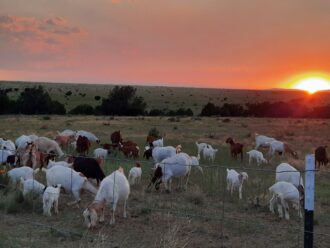New Mexico rancher Sydney Franz tested two approaches to kidding goats for economics and safety and found a clear winner.
Sydney Franz moved her goat ranch, K&C Boer Goats, from central Texas to Mora County, N.M. to partner with Turner Ranches. Their dream was to establish multi-species grazing for land restoration and improved profitability.
“In 2014, Turner Ranches believed that developing a multi-species grazing program with the addition of meat goats to his cattle would offer better pasture management practices and bring in additional income,” says Sydney.
There are many highs and lows of the ranching lifestyle, but losing animals to predation is a particularly difficult challenge to cope with. Predators like mountain lions and coyotes can cause enormous economic losses if they go unchecked.
Due to this predator pressure and the rough terrain of the Mora River Canyons, they adopted an Intensive Kidding program. In Intensive Kidding programs, does are contained in corrals for up to three months to kid out and raise their kids. All feed and water are provided, resulting in high feed cost, intensive labor and increased exposure to illness. Also noted is the lack of bonding between does and their offspring.
For Sydney, this lack of bonding resulted in abandoned kids, and kids who would not follow their mothers and the herd. This caused a higher kid loss from predators as kids were left behind the herd.
In contrast, the Extensive Kidding program is pasture-based, with the goats’ diet derived primarily from grazing, and birthing occurs on pasture with little or no human assistance.
Curious if an Extensive Kidding program would increase the number of live kids raised from birth to sale, as well as reducing labor and costs of kid goat production, Sydney applied for a Farmer/Rancher grant to compare the two systems.
What was Learned
Data collected over three years shows that an Extensive program of kidding does out in two connected traps can reduce the cost of feed and labor. It also demonstrated that those kids are able to follow their mothers earlier, resulting in a higher percentage of live kids surviving until market.
“Our project conclusively shows that having the most kids to market for the lowest expense is obtained through the Extensive Kidding Pasture use.”
Sydney did find one detrimental factor in using the Extensive Kidding program in open range – the lack of shelter during uncertain weather conditions. She believes this can be addressed through the construction of multiple portable A-farmer shelters.
Impact
Through the project’s outreach, which includes videos, other ranchers are looking into making changes. According to Sydney, one local ranch has adopted the Extensive Kidding program in their operations.
“Our dream is to re-introduce small ruminants (mainly goats) onto large ranches in multi-species grazing programs. Prior to receiving funding to determine a better kidding program, we were losing too many goats. The number of losses we were experiencing before we completed our Western SARE project was unsustainable."
